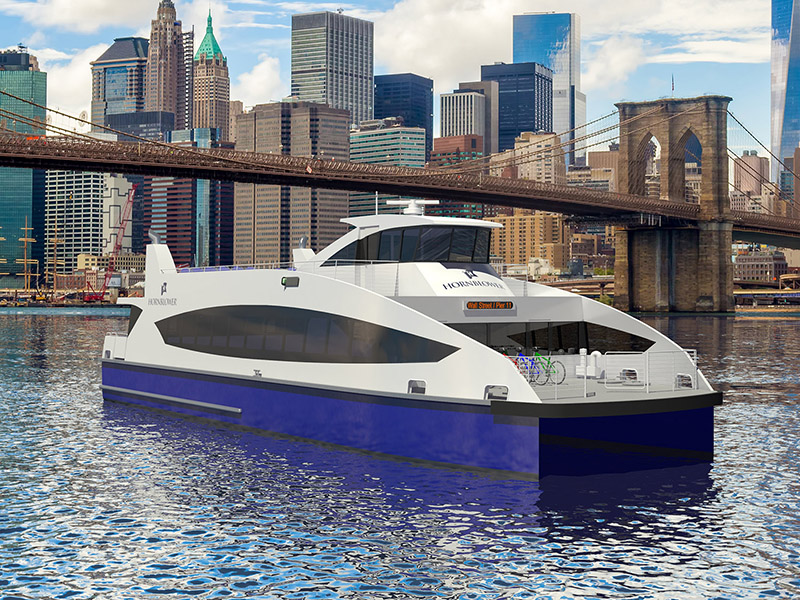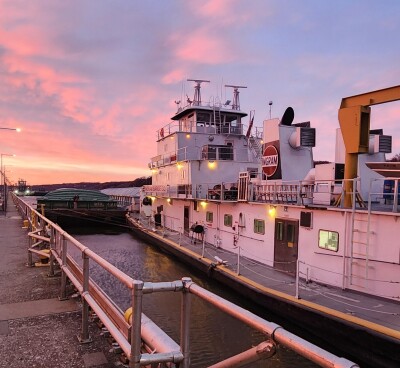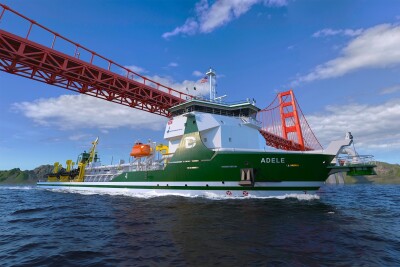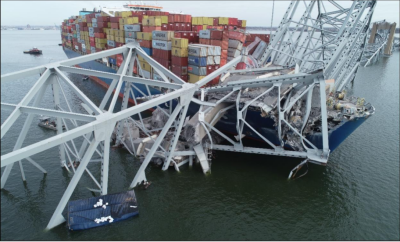(Bloomberg) — This time next year, New York Mayor Bill de Blasio plans to be campaigning for re-election touting his creation of a ferry service linking Manhattan with a string of fast-growing communities across the East River.
Potential economic benefits outweigh impacts from noise, engine exhaust and traffic, according to an administration review last month. Still, the system’s success hinges on its ability to attract millions of passengers with a $6.60-per-ride subsidy that would become more expensive to taxpayers if it serves fewer riders than the mayor predicts.
As de Blasio seeks a second term in 2017, boats will begin linking office buildings on Wall Street and Midtown to Astoria and the Rockaways in Queens, and the South Brooklyn neighborhoods of Bay Ridge and Red Hook. By 2018, the system will extend to the South Bronx. The administration foresees carrying 4.6 million riders a year, connecting to share-bike stations and even a streetcar along Brooklyn and Queens waterfronts not served by subways.
“We need new ways to connect people to each other and to jobs and to reclaim New York as a great coastal city,” said Alicia Glen, deputy mayor for economic development.
Empty Vessels
Doubters include Jeffrey Zupan, a senior fellow for transportation for the Regional Plan Association, the group that in 1929 advocated a northern Manhattan site for a Hudson River span now known as the George Washington Bridge. While agreeing that residents could benefit from more ferries, he says the city may be trying to do too much too fast.
“It has to be introduced in a measured way, incrementally, choosing with the best chance for success, rather than saying, ‘I’ll put all this service out there at once and then we’ll see what happens,’ ” Zupan said. “It’s very difficult to take away under-used routes after they’re offered to the public.”
The de Blasio administration estimates that running the ferries will cost $206 million over the six years of its contract with Hornblower Cruises & Events, a San Francisco-based operator of commuter ferries and tourist excursion boats, including to the Statue of Liberty and Ellis Island.
Another $170 million from municipal-bond proceeds would pay for construction of ferry landings, a home port in the Brooklyn Navy Yard and 19 new vessels. The city will also take over four boats operated by East River Ferry Service, an experimental route that has encouraged city officials by exceeding ridership expectations.
‘Sweet Spot’

A map of routes for New York's Citywide Ferry Service. NYC Economic Development Corp.
Several of the planned routes have so many stops along the East River that the ride could take too much time to be worthwhile, Zupan said.
“The sweet spot for a ferry user is if they are living on the shore, which means they’re not near the subway, but each time it stops, you’re making the trip longer and less attractive,” he said. “Some stops, like on Roosevelt Island in the East River, are odd because you have a subway there, so it’s redundant.”
In promoting the plan, the de Blasio administration hearkens back to more than a century ago, when dozens of ferryboats crossed the waterways. That was before the advent of the Brooklyn Bridge in 1883 and the construction of rail tunnels under the Hudson and East Rivers, much of which was completed by 1910, said Brian Cudahy, author of “Over and Back: The History of Ferryboats in New York Harbor.”
Moving Outward
Administration planners say a comprehensive system will be required in a city with a population likely to hit 9 million within 15 years. New York had more than 8.5 million residents last year, with Brooklyn, the Bronx and Queens each growing faster than Manhattan, according to a city analysis of U.S. Census Bureau data.
Brooklyn led the city in jobs growth with a 5.8% increase in 2014, the most recent year available, followed by Queens with 3.9%, the Bronx with 3.4% and Staten Island, 2.9%. Manhattan, where most people work, had an increase of 2.6%, or 63,000 jobs, according to a January 2016 state Labor Department report.
New Jersey’s Hoboken changed from an industrial town into a haven for young professionals thanks to its easy access to Manhattan by train, bus and ferry, and de Blasio’s administration sees water transit as a necessity as apartment towers and other developments rise up along New York’s Hudson and East River waterfronts.
Same Fare
De Blasio, a Democrat who pledged to fight income inequality, said having a systemwide ferry fare of $2.75 — the same as a subway or bus ticket — was important to make it affordable to New Yorkers no matter where they live.
“Some of the people who have the least access to transit include many of the people who have the lowest income, and these are the folks we are trying to get into the economy,” Glen said.
As a city entity, ferry fares wouldn’t be interchangeable with buses and subways, which are operated by the state-controlled Metropolitan Transportation Authority. While most of the ferry landings have been chosen for their proximity to MTA bus lines, transfers would require separate payment, and more expense for the riders. It also means the city has to bear the entire cost if ridership doesn’t meet expectations.
“The city’s initiatives are critical to employers, but they should be fully integrated with the MTA public transit system,” said Kathryn Wylde, president of the Partnership for New York City, a group of corporate chief executives that does policy research to promote the city’s economy.
A city-controlled transportation system would avoid the need to consult the state or seek its approval for making decisions on routes, frequency of boats and marketing the service.
The East River ferry, which began in 2013 with officials expecting 1.3 million passengers during a three-year pilot program, surpassed 1.6 million by mid-2014. Last year, almost 1.5 million boarded the boats, and officials expect more this year. The more riders, the lower the subsidy.
“Our old subway system was based on a hub-and-spoke model with everyone working in Manhattan and commuting out, but that is not where the jobs are growing and it’s not where the residential growth is,” Glen said. “It would be irresponsible if we we didn’t do what we could within our own jurisdiction and fiscal limits to increase services where people actually live and work these days.”
Bloomberg News by Henry Goldman





